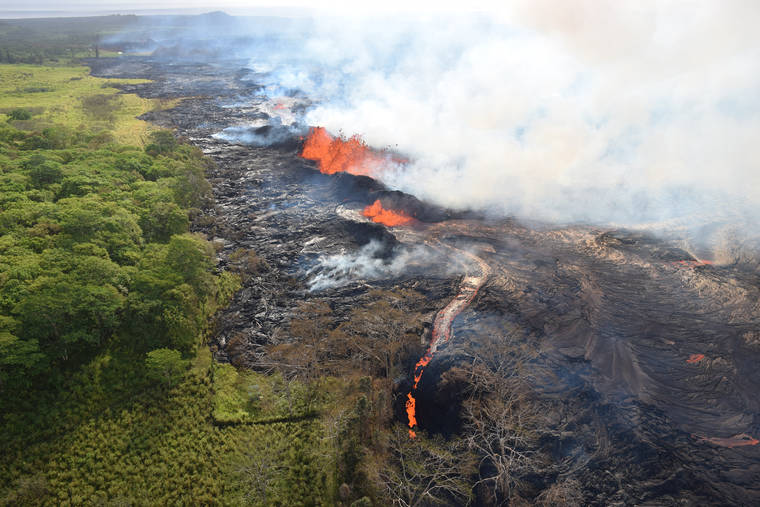Kilauea Volcano, on the Island of Hawaii, has two rift zones. The East Rift Zone is longer, with 50 km (about 31 miles) on land plus another 80 km (about 43 miles) below sea level. The Southwest Rift Zone, which is historically less active, is 40 km (about 20 miles) long with only a small portion underwater. The rift zones extend from Kilauea Caldera and, like the summit region, are prone to volcanic activity. But why are the rift zones so active?
Kilauea Volcano, on the Island of Hawaii, has two rift zones. The East Rift Zone is longer, with 50 km (about 31 miles) on land plus another 80 km (about 43 miles) below sea level. The Southwest Rift Zone, which is historically less active, is 40 km (about 20 miles) long with only a small portion underwater. The rift zones extend from Kilauea Caldera and, like the summit region, are prone to volcanic activity. But why are the rift zones so active?
Rift zones are areas of weakness in the volcano which form early in its lifetime, likely due to spreading of the volcano as it settles. This linear area that is being rifted, or pulled apart, remains active through most of the volcano’s building stages. Volcanic rift zones provide the easiest pathways for magma to travel underground from the summit storage region, with successive eruptions from the rift zones building up the volcano’s flanks.
The youngest Hawaiian volcanoes typically have two or three rift zones depending on whether they are built up against a neighboring volcano. In the case of Kilauea, there are only two rift zones because the volcano is buttressed against the southeastern slope of Mauna Loa. Kilauea’s two rift zones are nearly parallel to Mauna Loa’s rift zones reflecting this buttressing and the rift zones separate the relatively stable northern flank from the more mobile southern flank of the volcano. When magma intrudes into the rift, the northern flank remains stable against Mauna Loa Volcano to the north, and Kilauea’s southern flank is forced southward to accommodate the additional magma.
As pressure builds within the summit magma plumbing system, rift zone intrusions, like the 2018 intrusion into the lower East Rift Zone (LERZ), can occur. Intrusions are typically accompanied by increasing numbers of earthquakes as the magma strains and fractures the ground along its path. The earthquakes are concentrated at depths of 2–4 km (about 1.2–2.5 miles) below the ground surface, and periods of increased seismicity can last several hours to days as the intrusion progresses. In addition to seismicity, ground deformation also occurs during a rift zone intrusion. Inflation above the intrusion is measured by tilt and GPS stations showing upward and outward motion as the stations move away from the swelling rift zone.
As the magma ascends and forces its way through the rock, fracturing is mirrored on the ground surface with many parallel cracks above the intrusion. These cracks continue to widen as the rift is forced open, and the surface block above the intrusion subsides—forming a graben. If the intrusion reaches the surface, one or more fissures will open and erupt lava. Long curtains of lava fountains or spatter form as the lava erupts through cracks in the ground. As a fissure evolves, it typically transitions from erupting along a line to focusing at a single—or few—principal vent(s). This in turn can cause increased pressurization within the erupting system resulting in higher lava fountains.
Lava fountains are driven by the rapid formation of gas bubbles as magma rises to shallow depths, which then burst to create the pressurized lava at the surface. The bubbles form because pressure at shallow depths is low enough for the gas dissolved within the magma to escape, like bubbles forming when you open a carbonated drink. Besides lava flows, fissure fountains can produce spatter build-up adjacent to the vent in linear (spatter ramparts) or conical (spatter cone) formations. Spatter and tephra cones—a common feature along Kilauea’s rift zones—are likely to build when eruptive activity persists. The vent itself may also be enlarged by thermal erosion (slow melting of the vent walls by erupting lava) during prolonged activity at a vent. [DLG1]
When an eruption ends, the intrusion’s un-erupted magma drains back into the rift zone where it can remain molten for decades. In fact, lava with a chemical composition similar to the 1955 eruption was produced during the first week of the 2018 LERZ eruption, suggesting that the early fissures were supplied by stored magma. This illustrates that rift zones are not only essential for the transportation of magma within the volcano, but are also storing magma that could feed future eruptions.
Call 808-967-8862 for weekly Kilauea updates. Email questions to askHVO@usgs.gov.



